
















Bolt-Action Rifle or Semi-Auto Rifle?
Revolver or Semi-Auto Pistol?
Copyright © July 1, 2010 by Robert Wayne Atkins, P.E.
All Rights Reserved.
Introduction
 The debate over the advantages and disadvantages of the different types of firearms has been going on for at least one-hundred years.
The debate over the advantages and disadvantages of the different types of firearms has been going on for at least one-hundred years.
There is absolutely no way this short article will in any way influence that debate because the "battle lines" have already been drawn and too many individuals have already taken one side or the other. Once a person has taken a firm position on one of these topics and expressed his or her own firm opinion about the topic then it is almost impossible to get that individual to objectively analyze the subject from a fresh perspective because that person has already made up his or her own mind and therefore the subject is closed as far as he or she is concerned.
On the other hand, if you are flexible in your thinking and you are willing to objectively review all the facts before making a decision, then the following information may be of interest to you.
This article will review each of the following types of firearms:
- Bolt Action, Lever Action, and Semi-Auto Rifles.
- Revolvers and Semi-Auto Pistols.
The discussion of the above firearms will be based on accuracy, dependability, ease of use, and suitability for a specific application.
Accuracy
The accuracy of any firearm is directly related to all the following variables:
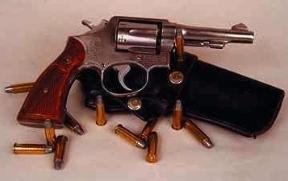
- The quality of the firearm or the company that made the weapon.
- The firearm itself.
- The condition of the firearm and how well it has been maintained.
- The type of sighting system used, such as iron sights, scope, or laser.
- The length of the barrel.
- The type of ammunition being used.
- The distance to the target and the prevailing environmental conditions.
- The skill of the individual shooting the firearm.
Let's examine each of the above topics one-at-a-time.
1. The quality of the firearm or the company that made the weapon.
The quality of a firearm will be directly proportional to its accuracy.
Each firearm manufacturer has its own unique manufacturing operations for the production of its firearms. Although these operations may be similar to those used by other companies they are not identical in every way. Therefore, there will be differences in the quality of the firearms made by different companies because of the different types of raw materials used, how those raw materials are brought together into the finished firearm, and the quality tolerances and procedures used at each step in the firearm manufacturing process.
In addition, the same exact company may also make different models of firearms from a variety of different raw materials using different quality standards for each type of raw material, such as stainless steel or blued steel.
Therefore, the quality of the firearms made by the same exact company will also be different.
However, the firearms made by a reputable high quality firearm manufacturer will normally always be superior to the firearms made by a low quality firearms manufacturer.
Therefore if you compared a high quality bolt-action rifle to a low quality semi-auto rifle then you would probably be impressed with the accuracy of the bolt-action rifle.
On the other hand, if you compared a high quality semi-auto rifle to a low quality bolt-action rifle then you would probably be impressed with the accuracy of the semi-auto rifle.
Therefore a broad general statement such as "All XXX type firearms are always superior to all YYY type firearms" would simply not be true.
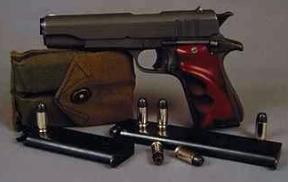 2. The firearm itself.
2. The firearm itself.
All the firearms of the same exact model made by the same exact company will not have identical accuracies.
There will always be some accuracy differences between these same exact firearms made by the same exact company.
The vast majority of them, or about 96%, will have what is known as the average accuracy for that particular firearm.
A small number of them, or about 2%, will have inferior accuracy for that particular firearm (a lemon).
And a small number of them, or about 2%, will have superior accuracy for that particular firearm (a cherry).
This is based on the bell shaped normal curve which does apply to firearm manufacturing.
Unless you have personally fired more than one of these identical firearms yourself in a side-by-side comparison under identical conditions using exactly the same type of ammunition, then you will not be able to determine whether or not the firearm you actually have is average, inferior, or superior in regards to accuracy.
Therefore to make any type of statement about the accuracy of any firearm based on the results of one of those firearms would be inappropriate. Unfortunately most of the review articles I have read on the internet and in a variety of firearm magazines are based on the accuracy of one and only one firearm as opposed to a random sample of five or ten of these identical firearms. Most of these articles include a review of the performance of different types of ammunition at different target distances but the conclusions are still based on using one firearm in all the tests.
3. The condition of the firearm and how well it has been maintained.
The bullet travels inside the bore of the firearm until it exits the firearm and then it continues on its way towards the target. Depending on the condition of the inside bore of the firearm the bullet may or may not hit the target where you originally aimed. Therefore, the condition of the inside bore of the firearm is extremely important to firearm accuracy.
If the firearm has been properly maintained during its entire life then the inside bore of the firearm should be clean and the internal grooves should be free of any type of powder, lead, or cleaning solvent buildup. If the internal bore is clean and it has not been damaged using the wrong type of cleaning tools or cleaning chemicals, or the improper use of those cleaning tools or chemicals, then the firearm will be as accurate as it can be based on the condition of its bore. But if the bore has been damaged in any way then the firearm will no longer be capable of placing shots in a reasonably accurate manner.
 4. The type of sighting system used, such as iron sights, scope, or laser.
4. The type of sighting system used, such as iron sights, scope, or laser.
Some iron sights are adjustable and some are not.
If the iron sights on your firearm are adjustable then you should take the time to learn how to properly adjust them for the type of ammunition you will normally be using at the average distance you will normally be shooting.
However, regardless of the quality of the iron sights on your firearm the accuracy of your firearm can be significantly improved with the addition of either a scope or a laser.
A scope is appropriate for a rifle.
A laser is appropriate for a handgun.
Regardless of whether or not you wear glasses your ability to see details gradually decreases with distance. If you are two feet away from a leaf then you can probably see all the details in the surface of that leaf. But if you are 100 yards away from that leaf then you will probably only be able to identify that it is a leaf and nothing more.
A scope magnifies objects and makes them easier to see. This is a significant advantage in helping you hold your rifle steady on the center of the target as you gradually squeeze the trigger. Therefore, at distances of 100 yards or more a person using a scope on a rifle will be more accurate than that same person shooting that same rifle without a scope at the same distance.
A laser allows you to see the approximate spot of bullet impact when you are standing within 50 yards of your target. The laser allows you to hold your handgun steady while you gradually squeeze the trigger. Therefore a person using a handgun laser will be more accurate than that same person shooting the same handgun without a laser at the same distance.
Therefore, when discussing firearm accuracy, either a riflescope or a handgun laser will significantly improve the accuracy of that firearm when compared to its original iron sights.
5. The length of the barrel.
On both a handgun and a rifle the longer the barrel the more accurate the weapon will be.
However, on both handguns and rifles there is a point of diminishing marginal returns and extra length beyond that point does not significantly improve accuracy and it may even reduce accuracy.
Therefore it is not fair to compare two firearms with different barrel lengths.
For example, it would not be fair to compare a rifle with a 20-inch barrel to a rifle with a 28-inch barrel.
It would also not be fair to compare a handgun with a 4-inch barrel to a handgun with a 7-inch barrel.
A longer barrel gives the longer weapon a decisive advantage in accuracy.
6. The type of ammunition being used.
In a handgun a heavier grain bullet is usually more accurate than a lighter grain bullet.
Some ammunition companies produce higher quality ammunition than other companies.
Even the same exact ammunition company has different grades of ammunition and their premium ammunition usually costs more than their target ammunition.
Therefore, it is not appropriate to compare different firearms if those firearms are shooting different grain weight bullets made by different companies because you are introducing another significant accuracy variable into the equation.
7. The distance to the target and the prevailing environmental conditions.
As the distance to the target increases the accuracy of the firearm at hitting that target decreases.
As the environmental conditions change, such as the speed and direction of the wind, then the accuracy of the firearm will be impacted.
The trajectory of the bullet does not remain constant on its way to the target and this also introduces another variable into the accuracy equation.
Therefore, distance, environmental conditions, and bullet trajectory all impact the accuracy of a firearm.
8. The skill of the individual shooting the firearm.
Some individuals are extremely skilled at shooting firearms and they can accurately hit targets that most of us cannot hit using the same exact firearm and ammunition.
Most of us are average marksmen and we can hit targets with an average degree of accuracy but we will never be able to replicate the performance of an expert marksman.
Therefore the individual shooting the firearm is another variable in the accuracy equation.
Accuracy Summary:
Based on the above there are many different variables that impact the accuracy of a firearm.
If you are interested in an honest comparison between two or more different firearms then you need to keep as many of the above variables as constant as possible to avoid having biased results in your final analysis.
(Note: One additional critical issue in the choice of a firearm is that the firearm should "feel right" when you are holding it. If the handgun feels comfortable in your hand then your average accuracy with that handgun will be better than a handgun that doesn't fit into your hand correctly. The same concept applies to rifles. The rifle should feel comfortable when holding it in a standard shooting position.)
Dependability
Dependability: Does the firearm function correctly every time you use it?
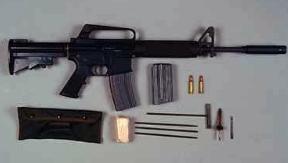 Historical review:
Historical review:
1. Some single-shot firearms have failed in use.
2. Some bolt-action rifles have failed in use.
3. Some lever-action rifles have failed in use.
4. Some semi-auto rifles have failed in use.
5. Some revolvers have failed in use.
6. Some semi-auto pistols have failed in use.
In other words, there is no mass produced firearm in the world that can claim it has never, ever failed in use.
If sand or any other type of debris gets into the internal moving parts of a revolver, or a bolt-action rifle, or a lever-action rifle, or a semi-auto then it will not function properly.
Disassembling, cleaning, and reassembling most semi-auto firearms and most bolt-action rifles is usually easier than disassembling, cleaning, and reassembling a revolver or a lever-action rifle.
Based on my past experience if you have a problem with a revolver then you will probably need to have it serviced by a professional gunsmith.
On the other hand, if you have a problem with a bolt-action rifle or a semi-auto firearm then you may be able to correct the problem yourself.
It should also be noted that there are some major differences in the dependability of some specific firearms because of:
1. the design of that specific firearm, or
2. the company that manufactured that firearm.
The published literature on the internet and in a variety of firearm publications contain numerous examples of specific "cheap" firearms that either: (1) have design defects, or (2) were made by a company using poor quality materials and low quality standards. These "cheap" firearms should definitely be avoided.
On the other hand, to say that one entire broad category of firearms is better than all the others is simply not logical.
For example, I could not honestly say that either a revolver or a semi-auto pistol is always more dependable than the other one.
In my opinion all the different broad categories of firearms are equal in terms of dependability.
I fully realize that this point of view is offensive to individuals who have already decided that one type of firearm is more dependable than all the others.
But that is my opinion based on my real world experience over the past forty years.
You are welcome to form your own opinion on this subject and it may be totally different from mine.
And that is okay with me.
Each of us is free to have his or her own opinion.
However, to claim that our "opinion" is a "fact" is being somewhat presumptuous.
The most important issue is to have a firearm that is clean and that has performed dependably for you in the past.
If you should need that firearm in the future then it will probably work in the same exact way it has in the past.
Trying to predict the odds that your firearm is going to fail when you really need it is an intellectual exercise I do not wish to participate in.
Ease of Use
Most firearms work in basically the same way:
1. Insert a cartridge into the firearm chamber.
2. Aim the firearm at a target.
3. Squeeze the trigger to fire the bullet.
When we talk about being easy to use we usually mean how easy it is to load the weapon and how easy it is to clean the firearm.
Most revolvers, most bolt-action rifles, and most lever-action rifles are easier to load than a semi-auto firearm.
You simply insert the cartridge into the firearm in its proper storage location and then use the firearm mechanism to move one of those cartridges into the firing chamber.
 On a semi-auto firearm you must first load the cartridges into a magazine, and then insert that magazine into the firearm, and then use the firearm mechanism to move one of those cartridges into the firing position.
On a semi-auto firearm you must first load the cartridges into a magazine, and then insert that magazine into the firearm, and then use the firearm mechanism to move one of those cartridges into the firing position.
Therefore, a semi-auto firearm is just a little more complicated to load because the magazine is outside the firearm and after you have the magazine loaded then you must properly insert the magazine into the firearm.
On the other hand, after you fire one round through a semi-auto firearm the next cartridge is automatically moved into the firing position.
This is much faster and much easier than using the mechanisms on a revolver, or a bolt-action rifle, or a lever-action rifle.
Therefore it is much, much easier to fire a second or third shot with a semi-auto firearm.
If you have preloaded magazines, the time to reload a semi-auto firearm to full capacity is only a few seconds.
Therefore it is much easier and much faster to reload semi-auto firearms if you have preloaded magazines available.
Finally, the capacity of most semi-auto firearms is more than the capacity of most revolvers, bolt-action rifles, and lever-action rifles.
Therefore, once the semi-auto firearm is loaded it will continue to shoot longer before you have to stop and reload it.
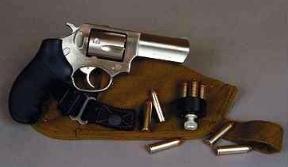 It is possible to purchase reloading clips for a bolt-action rifle and reloading wheels for a revolver, but their capacities are a lot less than semi-auto magazines.
It is possible to purchase reloading clips for a bolt-action rifle and reloading wheels for a revolver, but their capacities are a lot less than semi-auto magazines.
In addition, these devices are not as easy to use or as fast to use as simply ejecting an empty magazine and inserting a full magazine into a semi-auto firearm.
One of the primary arguments that is made against semi-auto firearms is that it takes the average person longer to learn how to use a semi-auto firearm.
This issue can be discussed for hours but the simple facts are those stated at the beginning of this section:
Most firearms work in basically the same way:
1. Insert a cartridge into the firearm chamber.
2. Aim the firearm at a target.
3. Squeeze the trigger to fire the bullet.
In my opinion there is almost no difference in how long it takes an average person to learn how to use any type of firearm.
Therefore I can not say that one type of firearm has an advantage over any other type of firearm based on how easy it is to learn how to use.
In my opinion, it does take a little more time and effort to clean semi-auto firearms when compared to the other types of firearms. However this is a negligible issue and a person should not make a firearm decision based on the small difference in the time and effort required to clean those firearms.
Therefore, based on an impartial review of all the above information it would appear that a person would be better advised to purchase a semi-auto firearm instead of a revolver, or bolt-action rifle, or lever-action rifle.
Suitability for a Specific Application
Firearms may be used in all the following situations:
1. Competition shooting events.
2. Casual target practice.
3. Hunting.
4. Combat.
5. Personal self-defense.
There are different categories for competition shooting events so if this is what you are interested in then you can find an event that specializes in almost any type of firearm you are personally interested in.
For the average person casual target practice is where they will use most of their ammunition. And casual target practice is also the subject of the vast majority of the firearm articles that have been posted on the internet and printed in a variety of firearm magazines. However, most of these articles attempt to extrapolate their target practice results to some other activity, such as hunting or combat or self-defense. The problem is that hunting and combat and self-defense are totally different from casually shooting at a target.
 There are two basic types of hunting activities:
There are two basic types of hunting activities:
1. Hunting for sport.
2. Hunting for survival.
When you are hunting for sport the success or failure of your day's adventure does not impact the survival of your family.
But when your family is depending on you to bring something home to eat then the situation is entirely different.
When confronted with starvation you do not wish to give the wild game animal a reasonable chance to escape. Therefore you will probably want to fire at least two or three quick shots into the animal's heart/lung chest cavity to seriously weaken it so it can not go very far after being shot. If you only put one round into the chest of the wild game animal then it could run away and die in a place where you will never be able to track it or find it. Therefore in a starvation survival situation you will probably want to put two or three quick shots into any wild game animal that you see. If you have a semi-automatic rifle then this is not too difficult to do. However, if you have a bolt-action or lever-action rifle then this is almost impossible to do.
(Note 1: Some hunting experts discourage firing more than one shot at a wild game animal for a number of reasons. For example, more shots mean more ruined meat. But which would you rather have: most of the meat or none of the meat?)
(Note 2: Please obey all your local, state, and federal hunting laws. These hunting laws normally limit the number of cartridges you can have in your firearm at one time when you are hunting wild game. This will normally require the purchase of one specially designed magazine that is blocked on its bottom so that no more than the legal number of cartridges can be inserted into that magazine.)
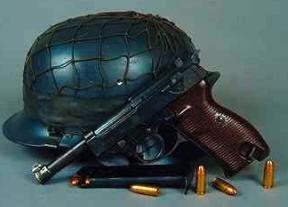 Combat is a totally different issue. In a combat situation the average soldier will almost always want to have a semi-automatic rifle for normal combat plus a semi-automatic pistol as an emergency backup weapon for close range encounters.
Combat is a totally different issue. In a combat situation the average soldier will almost always want to have a semi-automatic rifle for normal combat plus a semi-automatic pistol as an emergency backup weapon for close range encounters.
If you are unexpectedly confronted with a life-or-death personal self-defense situation then you will not have the time to think carefully and calmly the same way you do when you are shooting at targets. You will need to respond immediately with overwhelming force if you hope to survive. Overwhelming force means lots of ammunition that can be fired very, very quickly, and the ability to reload your firearm in seconds. You will not be able to call for a "time-out" while you try to reload your revolver or your bolt-action rifle or lever-action rifle. The individuals who are trying to kill you will take full advantage of your empty firearm and they will continue shooting at you until you are dead.
Therefore, in a survival hunting scenario, or a combat scenario, or a self-defense scenario the most appropriate choice would be a semi-automatic firearm. And if you can only carry one rifle and one handgun with you all the time, wouldn't it make good sense that those two weapons be semi-automatic firearms?
Conclusion
I have consistently recommended that individuals purchase semi-automatic firearms and learn the correct safe way to use them.
However, until I wrote this article I did not fully explain the reasons why I recommended semi-automatic firearms.
Now it is your turn to make a firearm choice that is appropriate for you and for your family.
And please believe me when I say I don't mind if you completely disagree with me and you select a firearm that is not semi-automatic.
Respectfully,
Grandpappy.
Footnote: Some Time-Honored Firearm Myths
The following statements about firearms have been around for at least fifty-years. When I was seriously considering the purchase of my first firearm about forty-years ago I was exposed to all of the following statements. And since these statements were printed in a variety of national firearm magazines and in some of the best firearm books available at that time, I simply accepted them as being true. However, with the passage of time and the opportunity to put these statements to a variety of real-world tests I have been able to gradually conclude that although each one is based on a small element of truth, the statement itself is really nothing more than a time-honored firearm myth.
- Bolt-action rifles are more accurate than semi-auto rifles.
- On the average this might be true.
- However, a high quality semi-auto rifle is usually more accurate than an inexpensive bolt-action rifle.
- A semi-auto rifle with a longer barrel is usually more accurate than a bolt-action rifle with a shorter barrel.
- Even when comparing two high-quality firearms with the same barrel length and shooting exactly the same ammunition at exactly the same distances, the bolt-action rifle is usually only a little more accurate than a semi-auto rifle. For example, an average shooter may be able to group his shots from a bolt-action rifle into a three-inch circle at 100 yards and into a six-inch circle at 200 yards. Using a semi-auto rifle the same exact average shooter may be able to group his shots into a four-inch circle at 100 yards and into an eight-inch circle at 200 yards. Therefore, the bolt-action rifle is indeed a "little bit more accurate" than the semi-auto rifle. However, when you consider that the typical kill zone circle on a deer or larger game animal is approximately an eight-inch circle then this difference is not relevant. It would also not be relevant in a combat situation when shooting at enemy soldiers. Therefore, the small difference in accuracy should not be a major factor in the choice of a firearm since both types of firearms will perform reasonably well in a typical hunting or combat situation in regards to accuracy.
- A revolver is more accurate than a semi-auto pistol.
- As explained at the very beginning of this article, firearm accuracy is dependent on a variety of factors such as barrel length and the quality of the firearm.
- Based on my own personal shooting experience, my accuracy with a revolver and a semi-auto pistol using iron-sights is basically the same. And as the barrel length gets shorter on both firearms then my average accuracy declines accordingly.
- Fortunately, the accuracy of both a revolver and a semi-auto pistol can be significantly improved by installing a laser on the handgun. This is especially true for short barrel handguns.
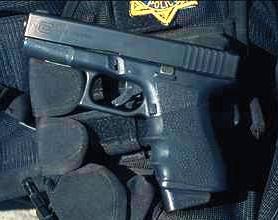
- A revolver is more dependable and less subject to misfires than a semi-auto pistol.
- On the average this might be true.
- However, a high quality semi-auto pistol, such as a Glock, will always out-perform an inexpensive revolver when it comes to average life expectancy and dependability.
- Therefore, just like the overwhelming vast majority of police officers, I would personally prefer to have a high-quality Glock semi-auto pistol instead of any revolver. This is not a "theoretical discussion issue" with a police officer because his or her life may occasionally depend on the handgun he or she is carrying.
- One shot one kill.
- This is pure Hollywood movie rubbish.
- Ask any experienced hunter, or police officer, or combat soldier about their opinion on this statement. After they finish laughing they will tell you that "occasionally" a single shot may be deadly but most of the time it takes multiple shots to do the job. (Note: Military snipers are trained to make every shot count and some of them come very close to achieving the goal of one shot one kill. But most of us are ordinary people, hunters, or police officers, and we are not military snipers in a military combat situation. Therefore we will be shooting for different reasons and under different conditions and, in my opinion, it is okay to bring down a big game animal with two or three shots when necessary.)
Grandpappy's e-mail address is: RobertWayneAtkins@hotmail.com




































 The debate over the advantages and disadvantages of the different types of firearms has been going on for at least one-hundred years.
The debate over the advantages and disadvantages of the different types of firearms has been going on for at least one-hundred years.
 2. The firearm itself.
2. The firearm itself. 4. The type of sighting system used, such as iron sights, scope, or laser.
4. The type of sighting system used, such as iron sights, scope, or laser. Historical review:
Historical review: On a semi-auto firearm you must first load the cartridges into a magazine, and then insert that magazine into the firearm, and then use the firearm mechanism to move one of those cartridges into the firing position.
On a semi-auto firearm you must first load the cartridges into a magazine, and then insert that magazine into the firearm, and then use the firearm mechanism to move one of those cartridges into the firing position. It is possible to purchase reloading clips for a bolt-action rifle and reloading wheels for a revolver, but their capacities are a lot less than semi-auto magazines.
It is possible to purchase reloading clips for a bolt-action rifle and reloading wheels for a revolver, but their capacities are a lot less than semi-auto magazines. There are two basic types of hunting activities:
There are two basic types of hunting activities: Combat is a totally different issue. In a combat situation the average soldier will almost always want to have a semi-automatic rifle for normal combat plus a semi-automatic pistol as an emergency backup weapon for close range encounters.
Combat is a totally different issue. In a combat situation the average soldier will almost always want to have a semi-automatic rifle for normal combat plus a semi-automatic pistol as an emergency backup weapon for close range encounters.

